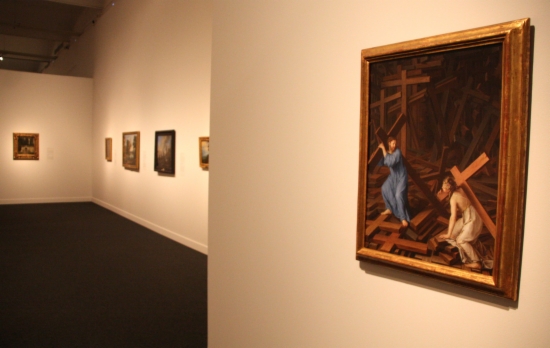Barcelona art museum CaixaForum exhibits a selection of the ´little treasures´ from Madrid's Prado
On the 16th July Barcelona art centre Caixaforumopened its last major exhibition of the season entitled ´Beauty captivates. Little treasures from the Museo del Prado´. The exhibition contains 135 small canvases from the great artists within Madrid´s museum collection such as Velázquez, El Greco, Rubens, Goya and Tiziano. It will run for almost six months, until the 5th of January 2015. The exhibition will enable visitors to contemplate the virtuosity of great masters of painting from the 14th to the 19th century dealing with small-scale works. It is the second largest collection of works that a host museumhas exhibited from the Museo del Prado, one of Europe's largest art collections.

Barcelona (ACN) - On the 16th July 2014 the Barcelonan art museum Caixaforumopened the doors of its last major exhibition of the season, and the second largest collection of works that a host museum has exhibited from Madrid's Museo del Prado. Two years ago Barcelona's Caixaforum – CaixaBank's art centre in the Catalan capital - displayed the exhibition ´Goya. Light and Shadows´. However, this year the focus has switched to a wide range of small-scale masterpieces from a variety of genres and time periods, selected from paintings exhibited at the Prado Museum. The current exhibition, ´Beauty captivates. Little treasures from the Museo del Prado´, is showcased exclusively for almost 6 months, until the 5th of January. It contains over 135 small canvases from the 14th to the 19th century, painted by a number of famous artists within Madrid´s museum collection and visitors will have the oppotunity contemplate the virtuosity of great masters such as El Greco, Veláquez, Rubens, Goya and Tiziano.
As the name suggests, all the works in the collection are seen as ´small treasures´, however the Curator of the exhibition, Manuela Mena, prefers to highlight the "intimacy and closeness" which the small paintings evoke, a feeling which far outbalances their size. The curator admits that the selection process required to obtain the 135 works was not an easy one as the Prado Museum holds more than a thousand paintings and sculptures which demonstrate the required characteristics.
The final selection of works have been chosen for their accurate representation of all time periods displayed in the Prado (from the 14th to the late 19th century), and to ensure that there is an even balance between all artistic styles and movements within he collection. Mena adds that, "the works have been chosen due to their high quality and the fact they contain curious elements which make them stand out". She also points out that the paintings are tied together by the broader themes of "paradise, hell and earth".
The visitor´s experience
However, in order to assist the visitor, the exhibition is divided into temporal and stylistic categories. It begins with artistic representations of religion and daily life in the Middle Ages and in the early Renaissance. It then continues to the 16th century Mannerism movement, in Italy and Spain, which leads into the Baroque period. Following that, you can find the 17th and 18th century collections, with the exhibition finishing with a section devoted to the work of Francisco Goya and other more recent artists from 19th century Romanticism.
The Curator, who also works as the Head of the Conservation of Paintings from the 18th Century and Paintings from Goya at the Museo del Prado, has advised the museum-goers that during their visit they should "imagine the artist painting" so that they might understand the closeness felt between the painter and his work so that "the enormous effort and concentration of the artist is directly exposed to us".
The origin of the small painting
Mena has located the source of the small painting in 14th century Europe, with the base of great altarpieces, or predellas, which contained images that told the more complete narrative of the central picture on the alter. However the worth of the small painting was really realised at the end of the late 16th century, when preparatory sketches for large-scale works became more valued. Indeed the popularity of the sketch "started to rise in the 16th century, and by the 17th century it was a major artistic genre" Mena has explained.
This trend coincided with the rise of the "cabinet canvas",which would be located near the social meeting rooms in houses and palaces, and in which smaller paintings were often demanded as a ´closer´ style of artwork for these rooms.
A collaborative exhibition
´Beauty captivates. Little treasures from the Museo del Prado´ is the most extensive collection of works from this museum that have travelled outside the Madrid-based gallery. The exhibition is organised in accordance with the collaboration signed in 2011 between the Prado´s staff and the social welfare scheme from the Catalan savings bank La Caixa (owner of CaixaBank), which, amongst other projects, collaborates in the organisation of exhibitions.
Since then, the two institutions have joined up to present the exhibitions: ´Goya. Lights and Shadows´ at Barcelona' CaixaForum, ´Rubens, Brueghel, Lorena. The Nordic landscape at the Prado´ in Valencia, Zaragoza, Seville and Palma, and ´Objects speak´ at the CaixaForumcentresin Lleida and Girona.